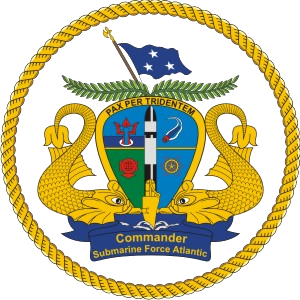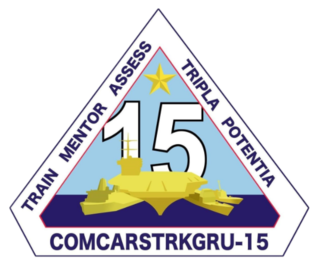
The United States Pacific Fleet (USPACFLT) is a theater-level component command of the United States Navy, located in the Pacific Ocean. It provides naval forces to the Indo-Pacific Command. Fleet headquarters is at Naval Station Pearl Harbor, Hawaii, with large secondary facilities at North Island, San Diego Bay on the Mainland.

The United States Fleet Forces Command (USFF) is a service component command of the United States Navy that provides naval forces to a wide variety of U.S. forces. The naval resources may be allocated to Combatant Commanders such as United States Northern Command (USNORTHCOM) under the authority of the Secretary of Defense. Originally formed as United States Atlantic Fleet (USLANTFLT) in 1906, it has been an integral part of the defense of the United States of America since the early 20th century. In 2002, the Fleet comprised over 118,000 Navy and Marine Corps personnel serving on 186 ships and in 1,300 aircraft, with an area of responsibility ranging over most of the Atlantic Ocean from the North Pole to the South Pole, the Caribbean Sea, Gulf of Mexico, and the waters of the Pacific Ocean along the coasts of Central and South America.

The Sixth Fleet is a numbered fleet of the United States Navy operating as part of United States Naval Forces Europe. The Sixth Fleet is headquartered at Naval Support Activity Naples, Italy. The officially stated mission of the Sixth Fleet in 2011 is that it "conducts the full range of Maritime Operations and Theater Security Cooperation missions, in concert with coalition, joint, interagency, and other parties, in order to advance security and stability in Europe and Africa." The current commander of the Sixth Fleet is Vice Admiral Eugene H. Black III.

The United States Second Fleet is a numbered fleet in the United States Navy responsible for the East Coast and North Atlantic Ocean. The Fleet was established following World War II. In September 2011, Second Fleet was deactivated in view of the United States Government's perception that the potential military threat posed by Russia had diminished. On 4 May 2018, Admiral John M. Richardson, the Chief of Naval Operations, announced plans to reestablish Second Fleet amid heightened tensions between NATO and Russia. It was reestablished on 24 August 2018, with Vice Admiral Andrew "Woody" Lewis in command.
A destroyer squadron is a naval squadron or flotilla usually consisting of destroyers rather than other types of vessel. In some navies other vessels, such as frigates, may be included. In English the word "squadron" tends to be used for larger and "flotilla" for smaller vessels; both may be used for destroyer units. Similar formations are used in non-English-speaking countries, e.g., the "escadrille"—which would translate directly as "squadron"—in France.
A submarine squadron (SUBRON) is a naval formation or unit in such states such as the United Kingdom, United States, and Russia/Soviet Union. In France the equivalent unit is the escadrille des sous-marins nucléaires d'attaque (ESNA), part of the French submarine forces.

The Supreme Allied Commander Atlantic (SACLANT) was one of two supreme commanders of the North Atlantic Treaty Organisation (NATO), the other being the Supreme Allied Commander Europe (SACEUR). The SACLANT led Allied Command Atlantic was based at Norfolk, Virginia. The entire command was routinely referred to as 'SACLANT'.

A carrier strike group (CSG) is a type of carrier battle group of the United States Navy. It is an operational formation composed of roughly 7,500 personnel, usually an aircraft carrier, at least one cruiser, a destroyer squadron of at least two destroyers or frigates, and a carrier air wing of 65 to 70 aircraft. A carrier strike group also, on occasion, includes submarines, attached logistics ships and a supply ship. The carrier strike group commander operationally reports to the commander of the numbered fleet, who is operationally responsible for the area of waters in which the carrier strike group is operating.

Commander, Submarine Force Atlantic (COMSUBLANT) is the Submarine Force U.S. Atlantic Fleet type commander under the United States Fleet Forces Command.

Commander, Naval Surface Force, Atlantic (COMNAVSURFLANT) is a post within the United States Fleet Forces Command. As Naval Surface Force Atlantic, it is a military formation, but the organization is often known as SURFLANT. Its headquarters are at the Naval Station Norfolk, Norfolk, Virginia. The current commander is Rear Admiral Brendan R. McLane. COMNAVSURFLANT supervises all surface ships based on the Eastern United States and Gulf Coast of the United States, as well as ships forwarded deployed to Naval Station Rota, Spain.

Henry Goodman Chiles Jr. is a retired United States Navy four star admiral who served as Commander in Chief, United States Strategic Command (USCINCSTRAT), from 1994 to 1996, the first naval officer to command all of the strategic nuclear forces of the United States.

The U.S. Tenth Fleet is a functional formation and a numbered fleet in the United States Navy. It was first created as an anti-submarine warfare coordinating organization during the Battle of the Atlantic in the Second World War. It was reactivated as a force provider for Fleet Cyber Command on 29 January 2010. U.S. Tenth Fleet serves as the numbered fleet for U.S. Fleet Cyber Command and exercises operational control of assigned naval forces to coordinate with other naval, coalition and Joint Task Forces to execute the full spectrum of cyber, electronic warfare, information operations, and signal intelligence capabilities and missions across the cyber, electromagnetic, and space domains.
Fleet Command is responsible for the command, operations, readiness, training and force generation of all ships, submarines, aircraft squadrons, diving teams, and shore establishments of the Royal Australian Navy. Fleet Command is headquartered at HMAS Kuttabul in Sydney, and is led by the Commander Australian Fleet (COMAUSFLT), also referred to as Fleet Commander Australia (FCAUST), which is a rear admiral (two-star) appointment.

Carrier Strike Group 14 was a U.S. Navy carrier strike group. The group was for some time the only U.S. carrier strike group that did not have an assigned aircraft carrier or carrier air wing. As of December 2010, it directed the cruisers USS Gettysburg (CG-64) and USS Philippine Sea (CG-58). Carrier Strike Group 14 was seemingly last based at Naval Station Mayport. Without a carrier flagship, it did not conduct the typical deployments of other carrier strike groups; instead, its two cruisers made independent voyages.

Carrier Strike Group 15, is a training formation of the United States Navy. It trains and certifies Pacific Fleet Carrier Strike Groups, Amphibious Ready Groups, and independently deploying surface ships. It replaced Commander, Strike Force Training Pacific in a title change. Carrier Strike Group Four is the equivalent command for US Fleet Forces ships.

Michael J. Connor, is a retired United States Navy Vice Admiral. Connor held several, concurrent titles during his last assignment including Commander, United States Submarine Forces (COMNAVSUBFOR), Commander, Submarine Forces Atlantic (COMSUBLANT) and Commander, Allied Submarine Command. Connor served as commander of the U.S. submarine forces from September 2012 until September 2015.

Vice Admiral Joseph Edward Tofalo is a United States Naval officer. Until 3 August 2018, he served as: Commander Submarine Forces; Commander Submarine Force Atlantic; Commander Task Force 144; Commander Task Force 84; Commander Allied Submarine Command.
Submarine Squadron Two was a United States Navy submarine squadron based at Groton, Connecticut.

Charles L. Munns, retired as a Vice Admiral in the United States Navy. Munns held several posts including Commander, United States Submarine Forces (COMNAVSUBFOR) and Commander, Submarine Force Atlantic (COMSUBLANT). Munns served as commander of the U.S. submarine force from 2004-2007.

Daryl Lane Caudle is a United States Navy admiral who is the 35th commander of United States Fleet Forces Command since December 7, 2021. He most recently served as commander of Naval Submarine Forces (COMSUBFOR), Commander, Submarine Force Atlantic (COMSUBLANT) and Commander, Allied Submarine Command (ASC). As COMSUBFOR, he was the undersea domain lead, and is responsible for the submarine force's strategic vision. As COMSUBLANT, he commanded all Atlantic-based U.S. submarines, their crews and supporting shore activities. These responsibilities also include duties as commander, Task Force (CTF) 114, CTF 88, and CTF 46. As commander, Allied Submarine Command, he was the principal undersea warfare advisor to all North Atlantic Treaty Organization (NATO) strategic commanders.














